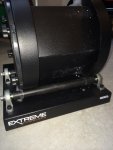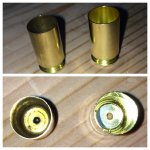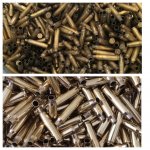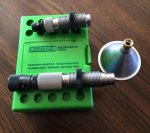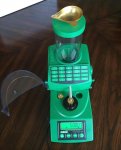So here is my process (pretend that the brass has been fired a few times, and the necks are getting brittle).
Using an electric drill, I take the lee case holding tool
http://www.midwayusa.com/product/476992/lee-case-trimmer-cutter-and-lock-stud
and the corresponding shell holder
http://www.midwayusa.com/product/271467/lee-case-length-gage-and-shellholder-308-winchester
And with this in the drill, I can turn case necks over a torch, to anneal the brass (you can quench brass, it doesn't harden like steel does in water).
Next, I use a Lyman tumbler. I let them tumble for a couple hours or so.
After that, I take my nice shiny brass inside, and I put some case lube on each one, one at a time (don't lube too close to the shoulder or the brass will buckle, you will learn this the hard way).
Next, I have my lee challenger, single stage press. I have the lee .308 die set (but we only use the full length die and the seating die, not the crimp.) the full length die also removes the spent primer (if you didn't already know.)
Now that all my cases have been reshaped, some brass has moved forward a couple thousandths of an inch. So here's where I use C-clamps to hold my Hornady case length trimmer to my reloading bench. It is incredibly accurate at trimming case length.
After all that is done, we have to clean the primer pockets with a primer pocket cleaning tool... Pretty self explanatory lol.
Okay, so now that our brass is annealed, cleaned, sized, and trimmed, were ready to prime them! I use my lee in-press priming tool, it takes longer to prime than a hand priming tool, but it has more torque.
Now the fun part, powder charge!
I use the lee perfect powder drop thingy that came with the challenger kit. It drops pretty dang close to what I want (it's micro-adjustable, but even just 3 granules of h4895 will throw the weight off 1/10th grain). So I drop a charge into my PRIMED case, then I pour the powder out onto my Frankfort armory electronic scale, 42.0 grains of h4895 is what my gun loves. After each case is charged, were ready for bullet seating.
I switch out my full length sizer die with my seating die. I then place each case in the holder, place a bullet on the case, and push er' in! No crimping required

Note: you will need to adjust your dies and case trimmer to the correct settings, which we can help you out with once you get there

If I forgot anything, I'll throw it in, I think I got it all though
Sent from my iPhone using Tapatalk

